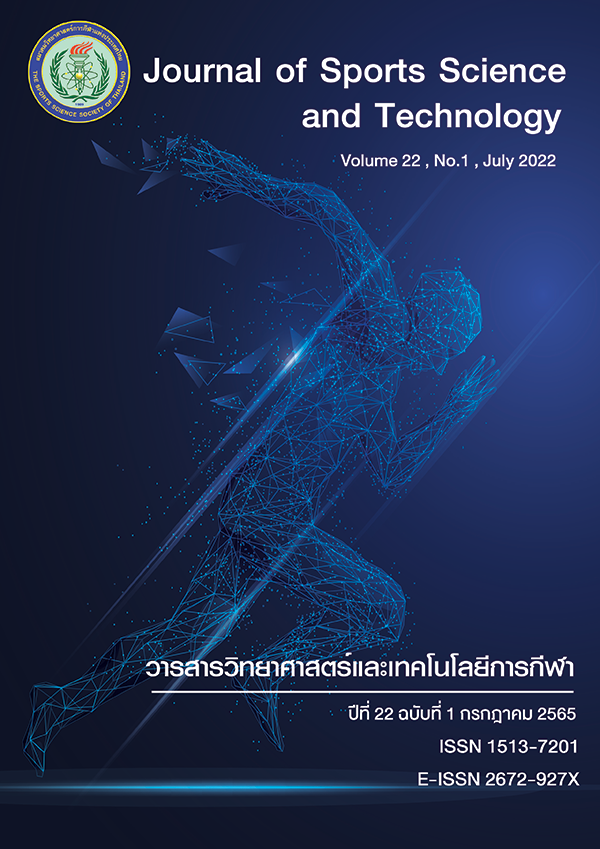PHYSICAL EXAMINATION THAT CAN IDENTIFY UNILATERAL PATELLAR TENDINITIS PATIENTS WITH LIMITED KNEE RANGE OF MOTION
DOI:
https://doi.org/10.14456/jsst.2022.6Keywords:
Knee joint, Patellar tendinitis, Physical examination, Physical therapyAbstract
Limited knee range of motion (ROM) is one problem in patients with patellar tendinitis. Although comprehensive examination is recommended, no study has previously identified specific examination relevant to limited ROM in these patients. This would help in minimizing time during physical examination. Objective: To investigate physical examination including palpation, muscle length, muscle strength, and passive movement test that can identify patellar tendinitis patients who had limited knee ROM.Methods: Fifty-nine patient records diagnosed as patellar tendinitis were included in this study. Knee ROM and muscle strength were recorded as actual scores, while palpation, muscle length and passive movement were recorded as categorical variables. An independent t-test was used to compare knee ROM between pain/no pain and tightness/no tightness, whereas one-way ANOVA with post-hoc Bonferroni was used to compare among normal/limited by pain/limited by resistance. Spearmen’s correlation test was used to determine correlation between ROM and muscle strength.Results: Tenderness at popliteus muscle, iliotibial band tightness, hamstring muscle strength, and limited by pain during passive movement test in flexion with adduction, posteroanterior, anteroposterior, extension with abduction and extension with adduction significantly affected (P<0.05) knee flexion ROM. Limited by resistance during passive movement test also significantly affected (P<0.05) knee extension ROM.
Conclusion: Limited knee flexion suggests problem with tenderness at popliteus muscle, iliotibial band tightness, hamstring muscle strength, and limited knee mobility by pain, while limited knee extension primarily indicates problem with limited knee mobility by resistance. These findings may help physical therapists to select appropriate physical examination in patients with patellar tendinitis who has limited knee ROM.
(Journal of Sports Science and Technology 2022; 22(1):70-85)
(Received: 16 October 2021, Revised: 22 February 2022, Accepted: 2 March 2022)
*Corresponding author: Warinda INTIRAVORANONT
Physical Therapy Center, Faculty of Physical Therapy, Mahidol University
999 Phuttamonthon 4 Road, Salaya,Nakhon Pathom, Thailand.
Email: warinda.int@mahidol.ac.th
References
2. Figueroa D, Figueroa F, Calvo R. Patellar tendinopathy: Diagnosis and treatment. J Am Acad Orthop Surg. Dec 2016;24(12):e184-e192. doi:10.5435/jaaos-d-15-00703
3. Malliaras P, Cook J, Purdam C, Rio E. Patellar tendinopathy: Clinical diagnosis, load management, and advice for challenging case presentations. J Orthop Sports Phys Ther. Nov 2015;45(11):887-98. doi:10.2519/jospt.2015.5987
4. Crossley K, Bennell K, Green S, McConnell J. A systematic review of physical interventions for patellofemoral pain syndrome. Clin J Sport Med. Apr 2001;11(2):103-10. doi:10.1097/00042752-200104000-00007
5. Jayaseelan DJ, Scalzitti DA, Palmer G, Immerman A, Courtney CA. The effects of joint mobilization on individuals with patellofemoral pain: a systematic review. Clin Rehabil. Jun 2018;32(6):722-733. doi:10.1177/0269215517753971
6. Shelbourne KD, Biggs A, Gray T. Deconditioned knee: The effectiveness of a rehabilitation program that restores normal knee motion to improve symptoms and function. N Am J Sports Phys Ther. May 2007;2(2):81-9.
7. Simpson BG, Simon CB. Lower extremity thrust and non-thrust joint mobilization for patellofemoral pain syndrome: a case report. J Man Manip Ther. May 2014;22(2):100-7. doi:10.1179/2042618613y.0000000042
8. Flandry F, Hommel G. Normal anatomy and biomechanics of the knee. Sports Med Arthrosc Rev. Jun 2011;19(2):82-92. doi:10.1097/JSA.0b013e318210c0aa
9. Magee DJ. Orthopedic physical therapy assessment. Elsevier Health Sciences; 2013.
10. Nordin M, Frankel VH. Basic biomechanics of the musculoskeletal system. Lippincott Williams & Wilkins; 2001.
11. van der Worp H, van Ark M, Roerink S, Pepping GJ, van den Akker-Scheek I, Zwerver J. Risk factors for patellar tendinopathy: a systematic review of the literature. Br J Sports Med. Apr 2011;45(5):446-52. doi:10.1136/bjsm.2011.084079
12. Hengeveld E, Banks K. Maitland's Peripheral manipulation: Management of neuromusculoskeletal disorders. 5th ed. vol 2. Elsevier Health Sciences; 2013.
13. Rudavsky A, Cook J. Physiotherapy management of patellar tendinopathy (jumper's knee). J Physiother. Sep 2014;60(3):122-9. doi:10.1016/j.jphys.2014.06.022
14. Norkin CC, White DJ. Measurement of joint motion: A guide to goniometry. F.A. Davis Company; 2016.
15. Kendall FP, McCreary EK, Provance PG. Muscles: Testing and function with posture and pain. Lippincott Williams & Wilkins; 2005.
16. Ullrich K, Krudwig WK, Witzel U. Posterolateral aspect and stability of the knee joint. I. Anatomy and function of the popliteus muscle-tendon unit: an anatomical and biomechanical study. Knee Surg Sports Traumatol Arthrosc. Mar 2002;10(2):86-90. doi:10.1007/s00167-001-0268-5
17. Wood A, Boren M, Dodgen T, Wagner R, Patterson RM. Muscular architecture of the popliteus muscle and the basic science implications. Knee. Mar 2020;27(2):308-314. doi:10.1016/j.knee.2019.12.001
18. Strauss EJ, Kim S, Calcei JG, Park D. Iliotibial band syndrome: evaluation and management. J Am Acad Orthop Surg. Dec 2011;19(12):728-36. doi:10.5435/00124635-201112000-00003
19. Hudson Z, Darthuy E. Iliotibial band tightness and patellofemoral pain syndrome: a case-control study. Man Ther. Apr 2009;14(2):147-51. doi:10.1016/j.math.2007.12.009
20. Furia JP, Rompe JD, Cacchio A, Del Buono A, Maffulli N. A single application of low-energy radial extracorporeal shock wave therapy is effective for the management of chronic patellar tendinopathy. Knee Surg Sports Traumatol Arthrosc. Feb 2013;21(2):346-50. doi:10.1007/s00167-012-2057-8
21. Wang CJ, Ko JY, Chan YS, Weng LH, Hsu SL. Extracorporeal shockwave for chronic patellar tendinopathy. Am J Sports Med. Jun 2007;35(6):972-8. doi:10.1177/0363546506298109
22. Warden SJ, Metcalf BR, Kiss ZS, et al. Low-intensity pulsed ultrasound for chronic patellar tendinopathy: a randomized, double-blind, placebo-controlled trial. Rheumatology (Oxford). Apr 2008;47(4):467-71. doi:10.1093/rheumatology/kem384
23. Draper CE, Besier TF, Santos JM, et al. Using real-time MRI to quantify altered joint kinematics in subjects with patellofemoral pain and to evaluate the effects of a patellar brace or sleeve on joint motion. J Orthop Res. May 2009;27(5):571-7. doi:10.1002/jor.20790
24. Wilson NA, Press JM, Koh JL, Hendrix RW, Zhang LQ. In vivo noninvasive evaluation of abnormal patellar tracking during squatting in patients with patellofemoral pain. J Bone Joint Surg Am. Mar 1 2009;91(3):558-66. doi:10.2106/jbjs.G.00572
25. Witvrouw E, Lysens R, Bellemans J, Cambier D, Vanderstraeten G. Intrinsic risk factors for the development of anterior knee pain in an athletic population. A two-year prospective study. Am J Sports Med. Jul-Aug 2000;28(4):480-9. doi:10.1177/03635465000280040701






